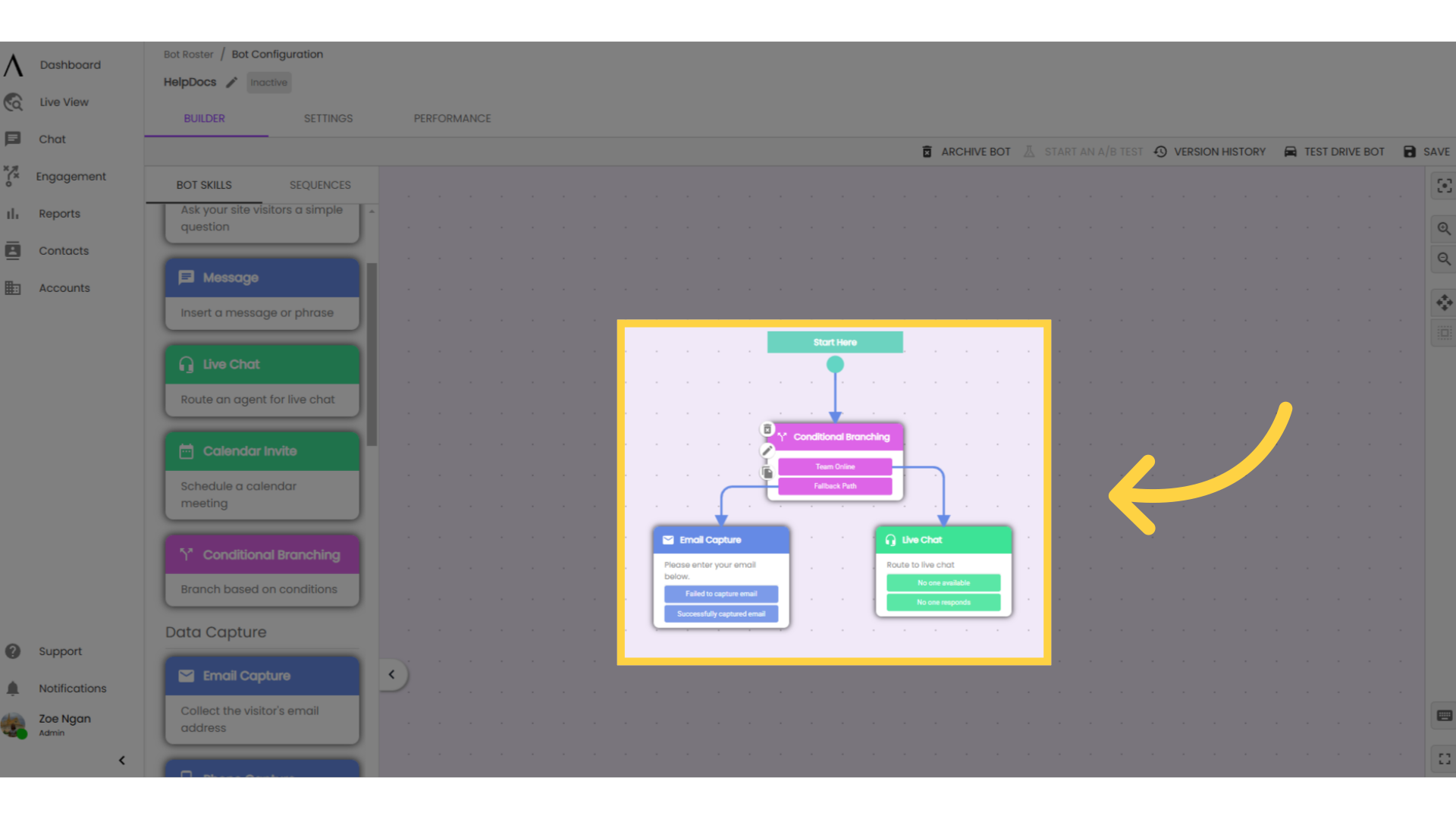All Categories > > Conditional Branching Skill
Conditional Branching Skill
- Conditional Branching Skill
- Go to app.getsignals.ai
- 1. Introduction
- 2. Insert "Conditional Branching" skill
- 3. Add New Branch
- 4. Define your branch criteria:
- 5. Logic Conditions: Web Page
- 6. Demographics:
- 7. Visitor Behaviour:
- 8. Availability:
- 9. Visitor Information:
- 10. Contact Information
- 11. Custom Contact Fields
- 12. Create a custom contact field
- 13. Account Information
- 14. Segments
- 15. Multiple branches:
- 16. Branch priority:
- 17. Configure fallback path
- 18. Common Uses
- 19. Data capture use case:
- 20. Regional routing use case:
- 21. Agent/Team availability use case:
Conditional Branching Skill
The conditional branching skill creates different branches in your bot flow based on any number of conditions that you define in the skill.
Go to app.getsignals.ai
1. Introduction
If you're already an expert bot-builder and are just looking for more technical information, we have additional HelpDocs videos on Managing Branches and Using Conditional Branching.
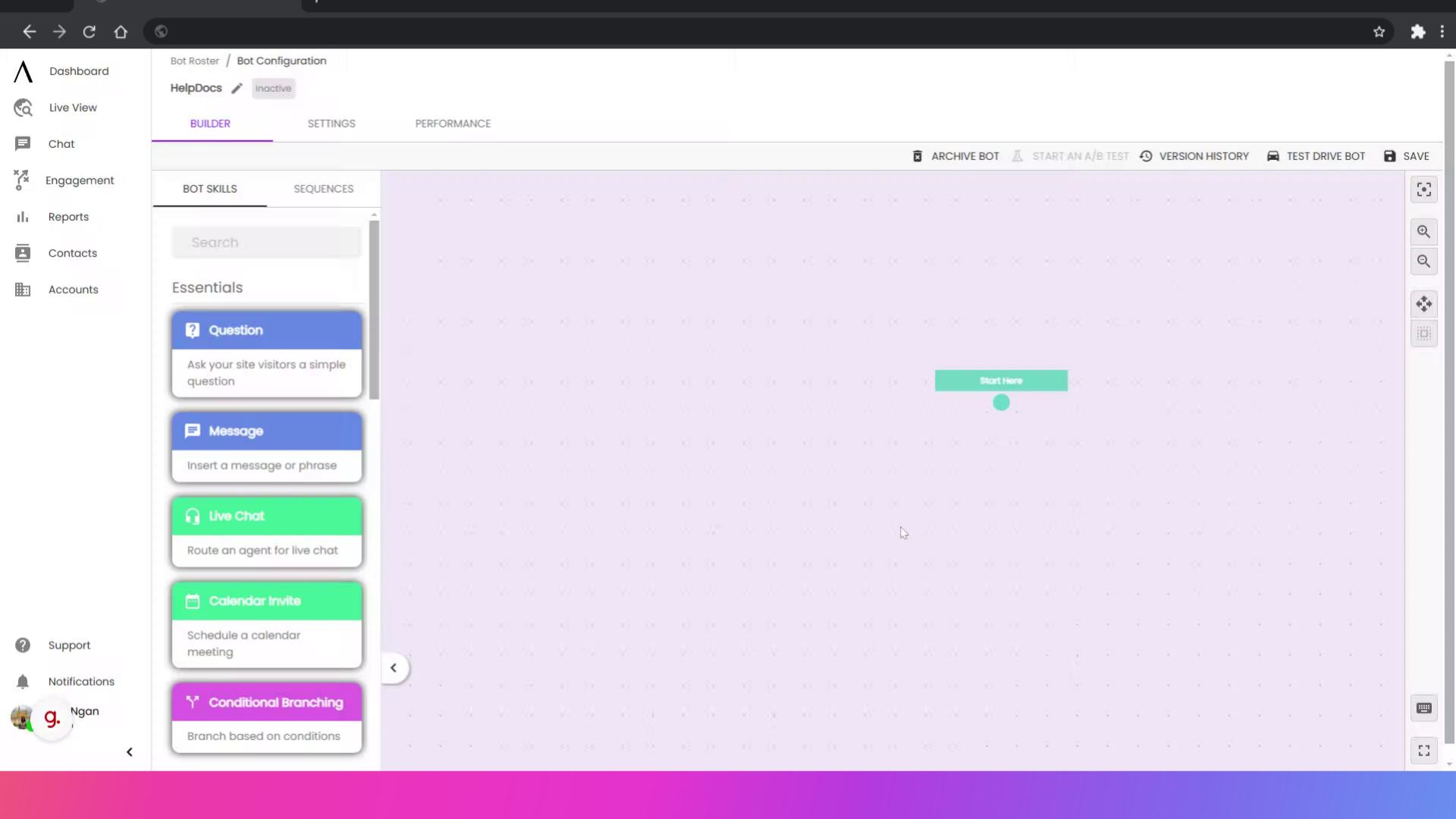
2. Insert "Conditional Branching" skill
Insert a conditional branching skill.
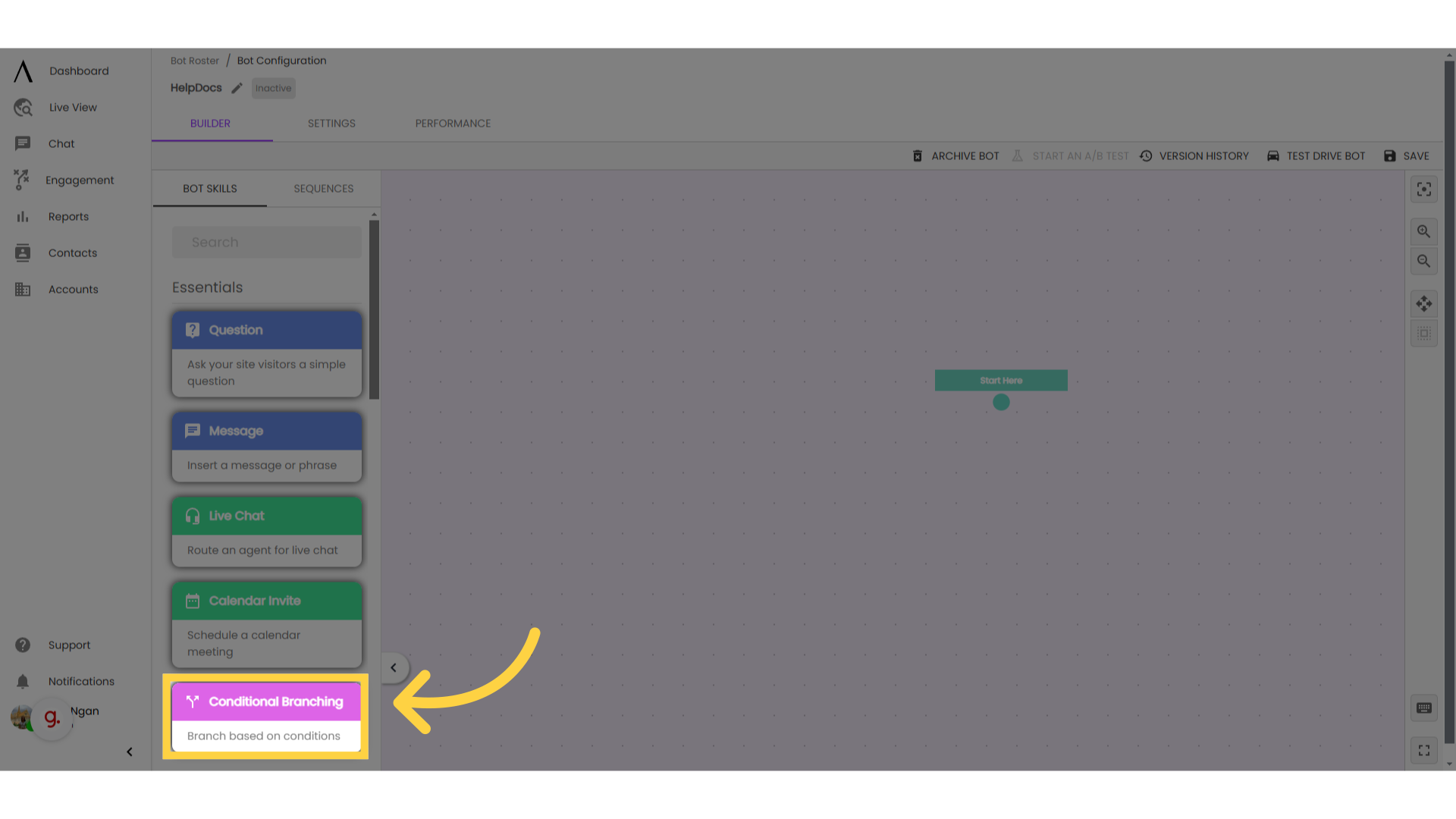
3. Add New Branch
Double-click to edit your skill and "Add New Branch."
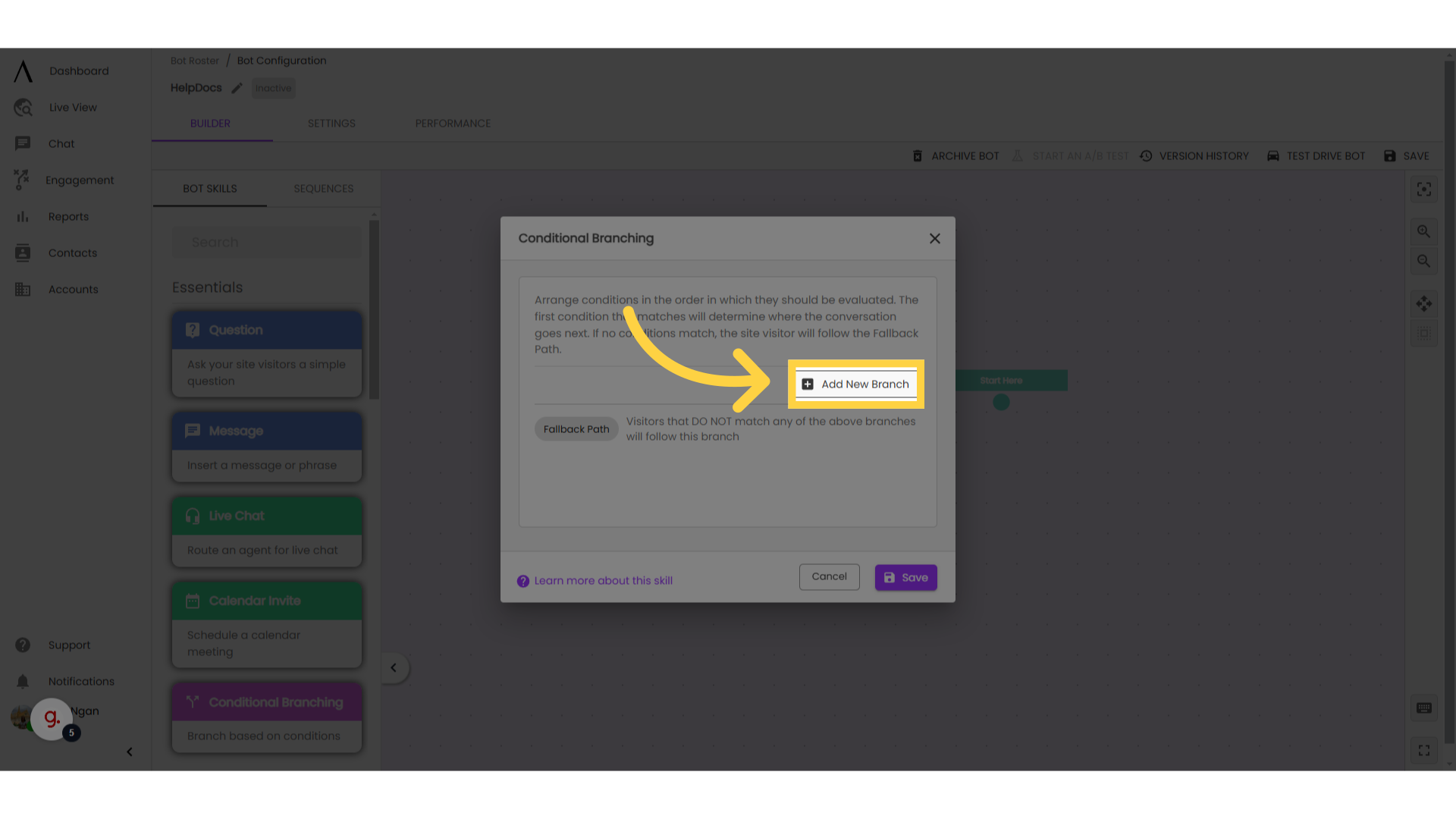
4. Define your branch criteria:
Name the branch, define the criteria, and save. Repeat for all desired branches, then click save and close.
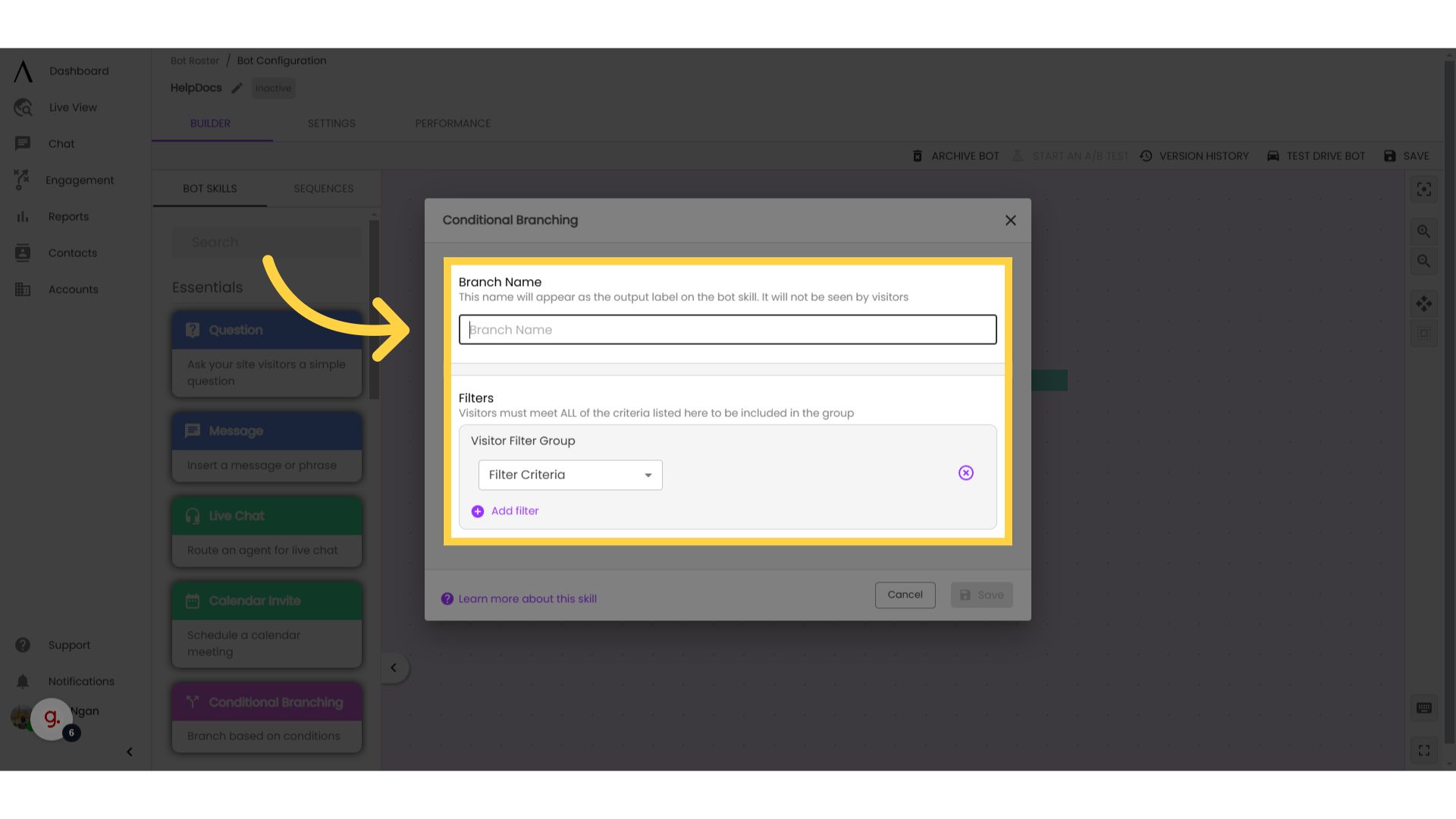
5. Logic Conditions: Web Page
The web page skill will check the visitor's current web page URL. Logical criteria include:
URL is exactly _______
URL contains _______
URL does not contain _______
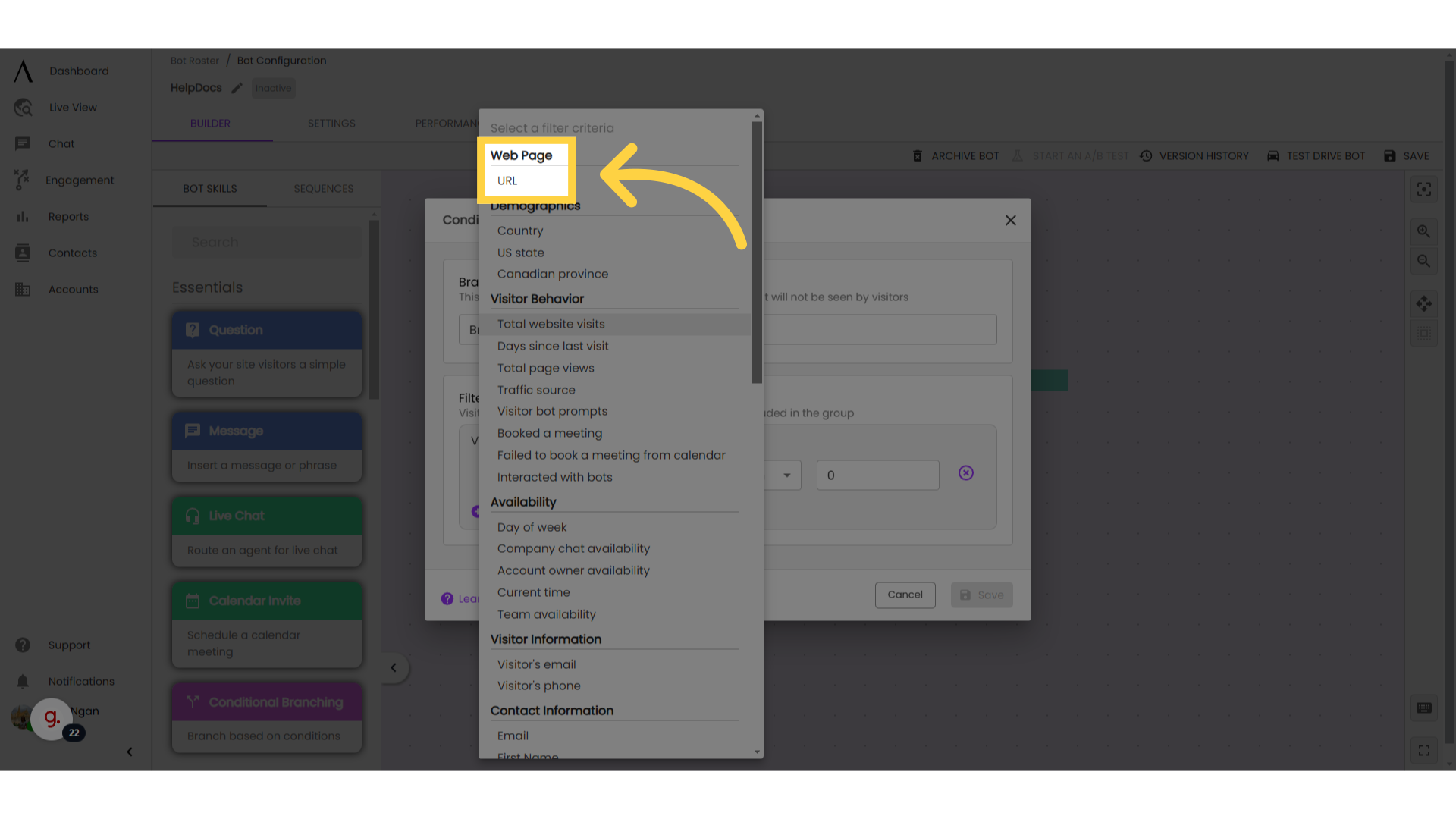
6. Demographics:
Demographic information is captured based on the web visitor’s publicly available IP address.
Country: Evaluates the country where your web visitors are chatting in from based on IP address. When setting up a branch, you can select multiple countries in the country drop-down menu.
The system supports the following comparison operators:
In - selected countries are included in the branch
Not in - selected countries are excluded from the branch US State and Canadian Province work the same way.
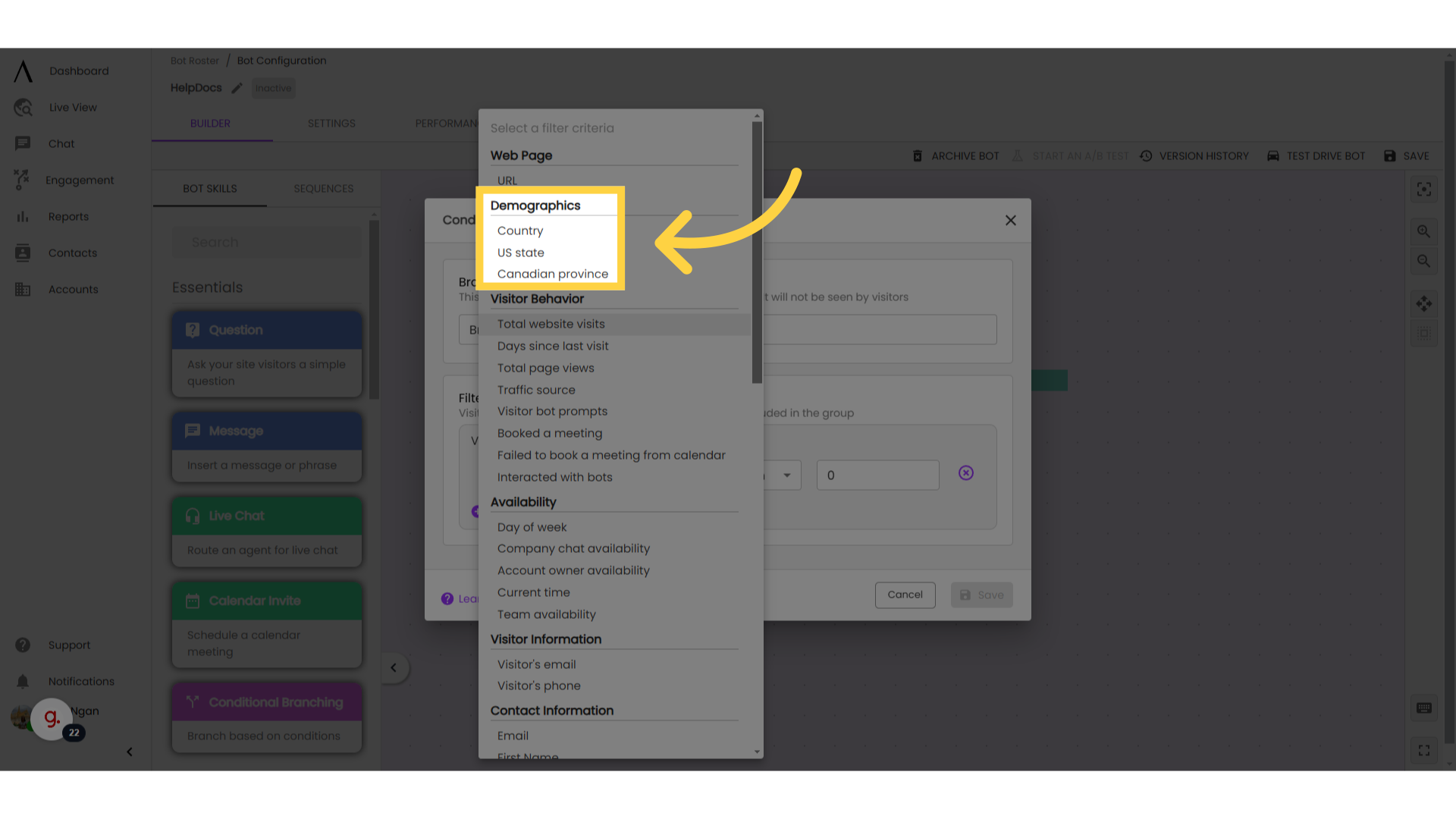
7. Visitor Behaviour:
This is pretty straightforward. You can branch visitors on information gathered by their cookies, such as total website visits and days since their last visit.
Total page views is how many times the web visitor has visited a page on your website. For example, if a web visitor visits the same URL on your site two times, this will count once toward total website visits and twice to total page views.
Visitor bot prompts is how many times a bot has been presented to this web visitor on your site. The available comparisons are “greater than”, “less than” or “equals”.
The available comparisons are "greater than," "less than," or "equals." You can also choose to branch on whether visitors have booked a meeting, were shown a calendar but failed to book a meeting, or if they've interacted with bots. For example, you can configure one of your bots, “Bot 1”, to appear if web visitor has interacted with another one of your bots, “Bot 2”.
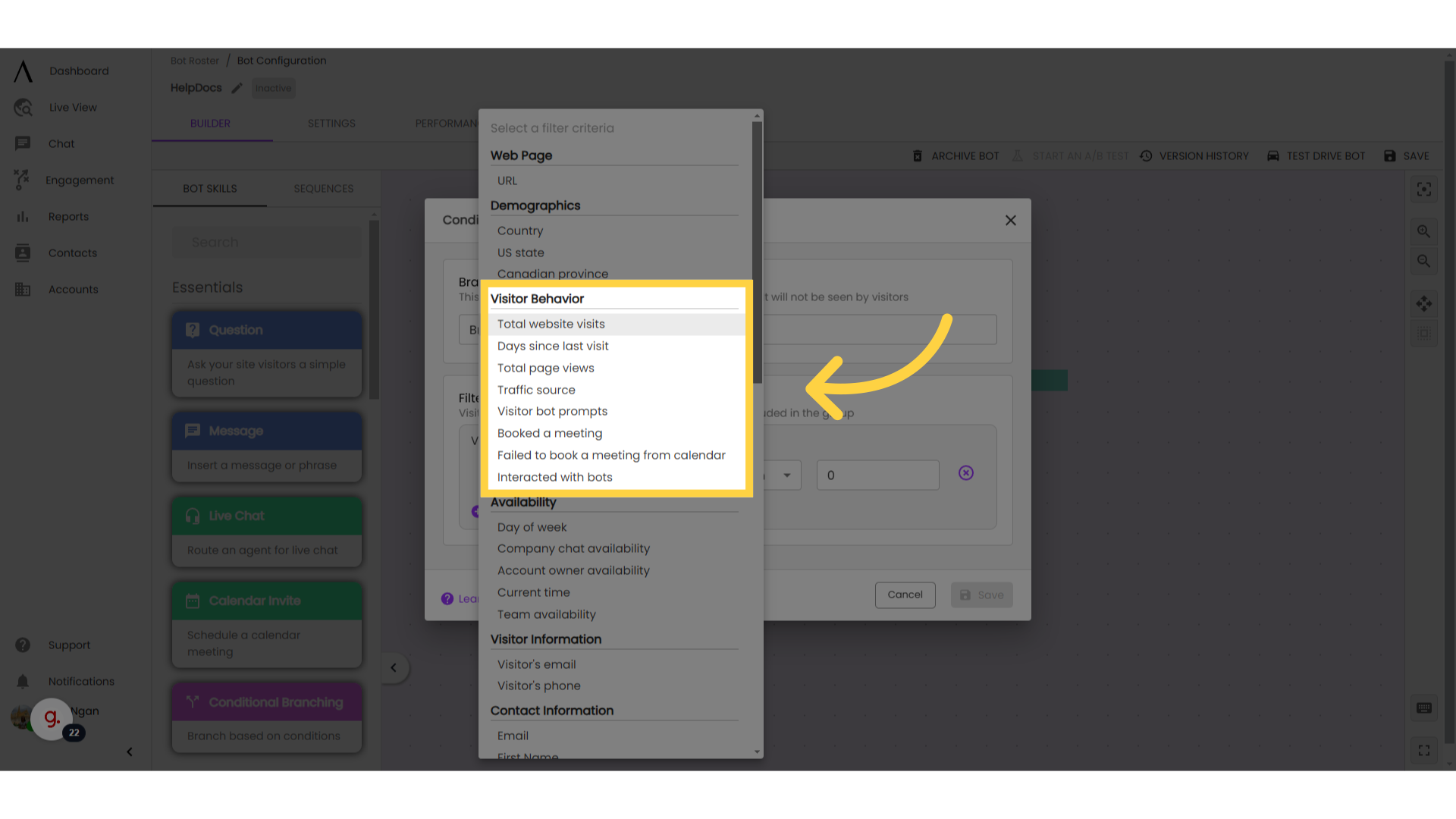
8. Availability:
The Availability criteria allows you to conditional branch based on the day of week, whether or not the visitor is vising during company chat availability times, current time, or team availability.
Check out our other HelpDocs videos to learn more about company chat availability and team availability.
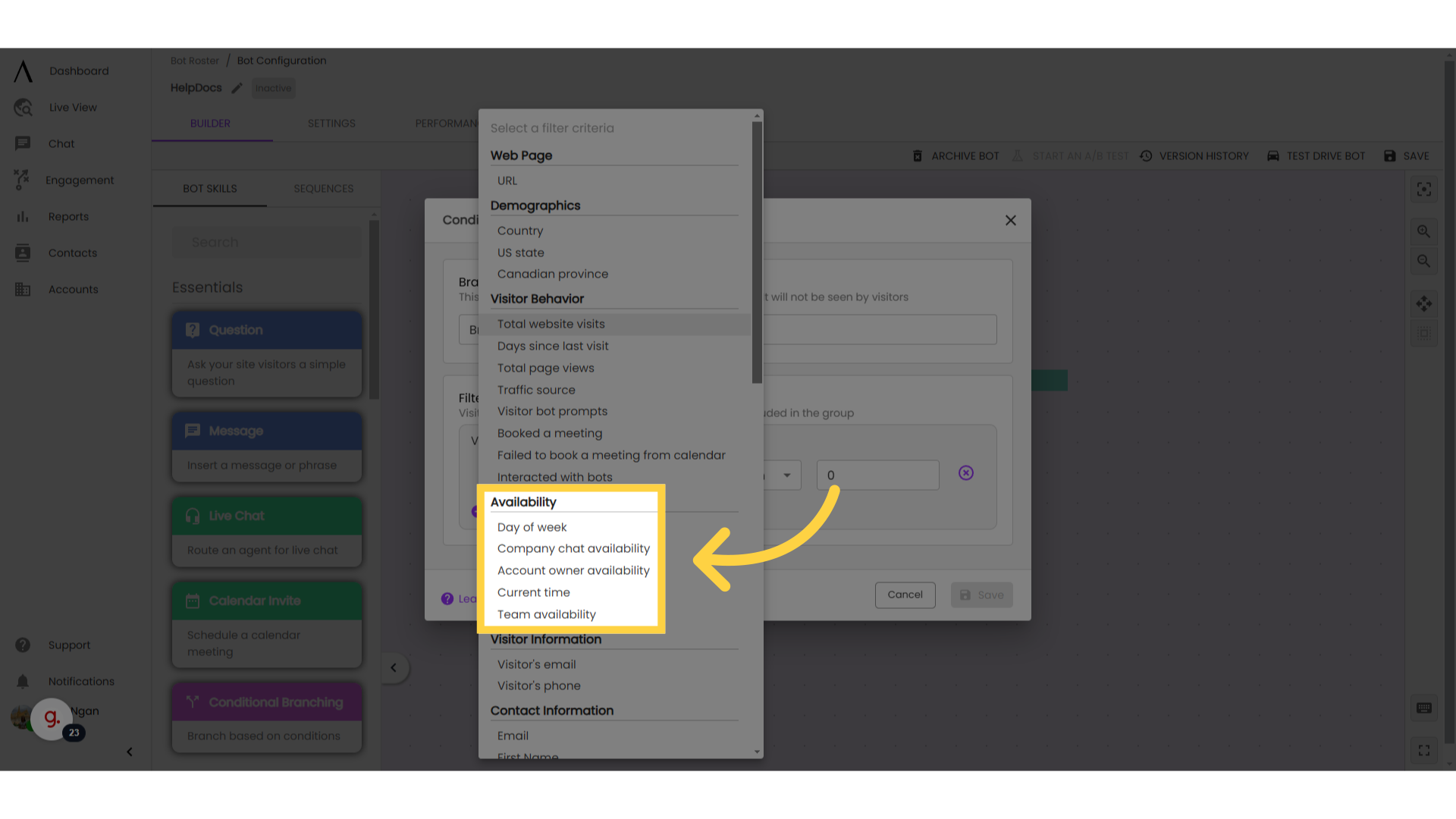
9. Visitor Information:
The visitor information criteria allow you to set conditions based on whether or not certain contact information is known. You can branch visitors based on whether or not the web visitor has a value specified in the email or phone field of their contact record.
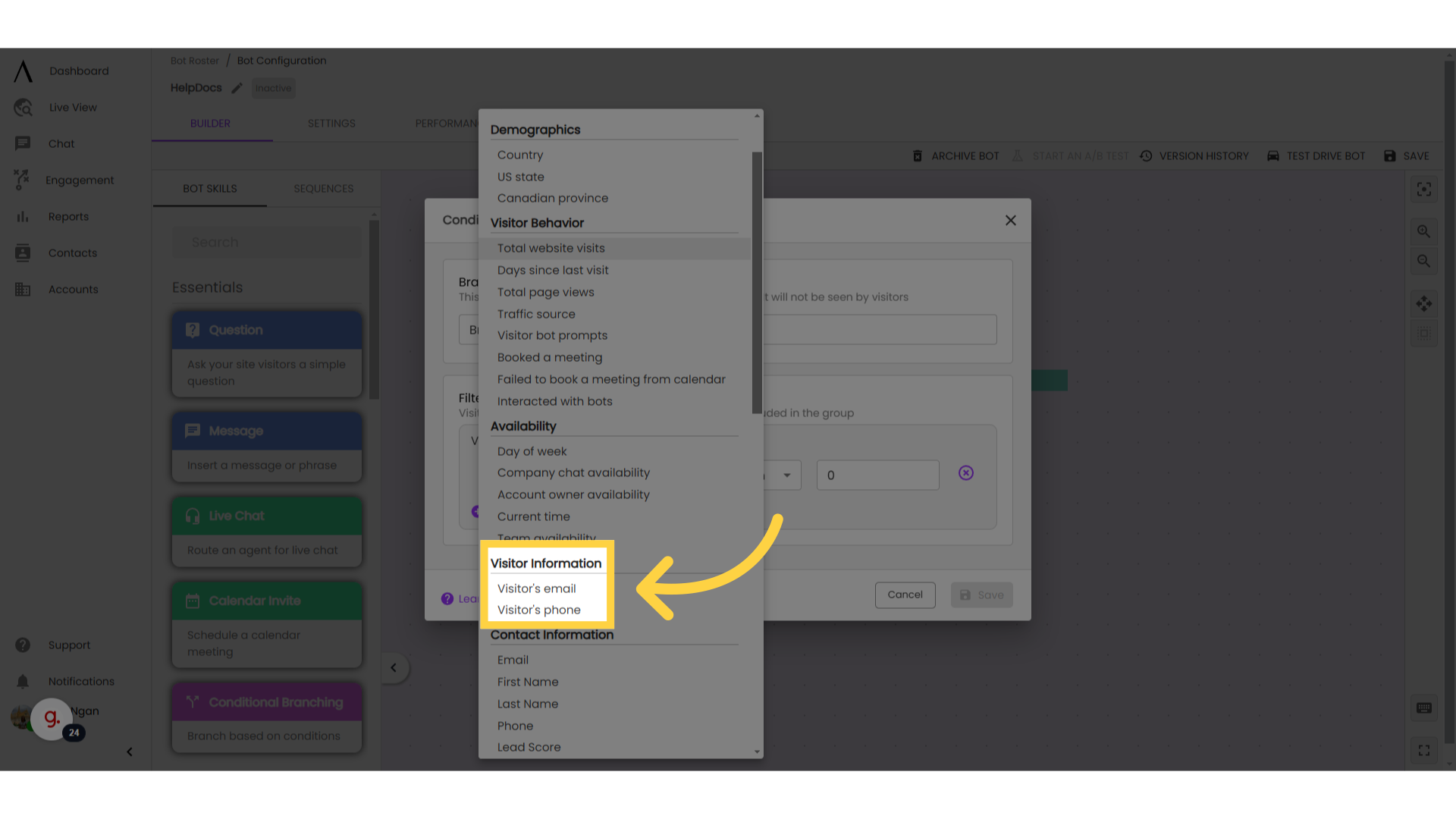
10. Contact Information
Create branches based on any saved fields in the web visitor’s contact record. All contact fields will appear in the drop-down menu for this criterion, including custom contact attributes.
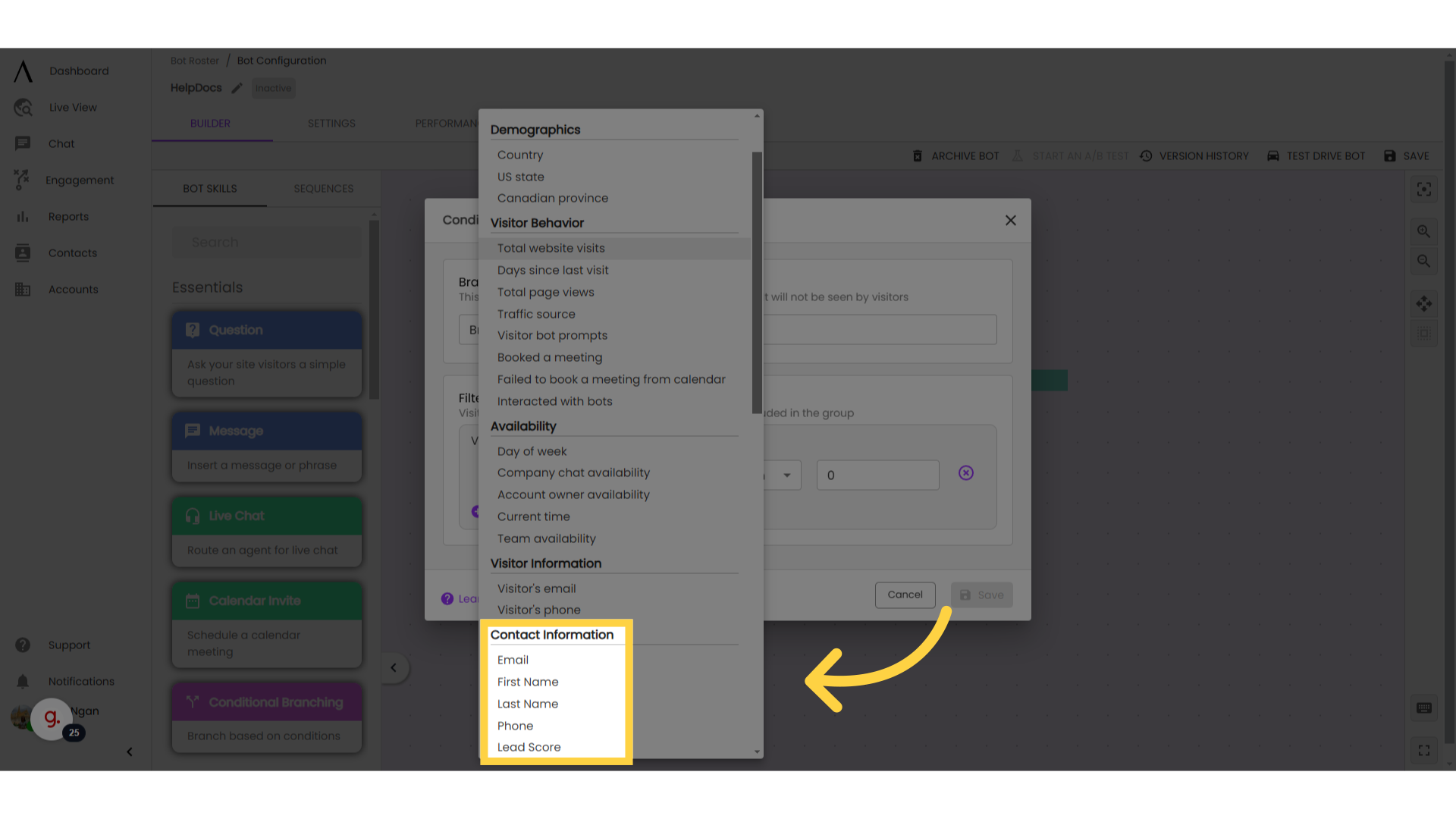
11. Custom Contact Fields
Branching off a custom contact field is also available.
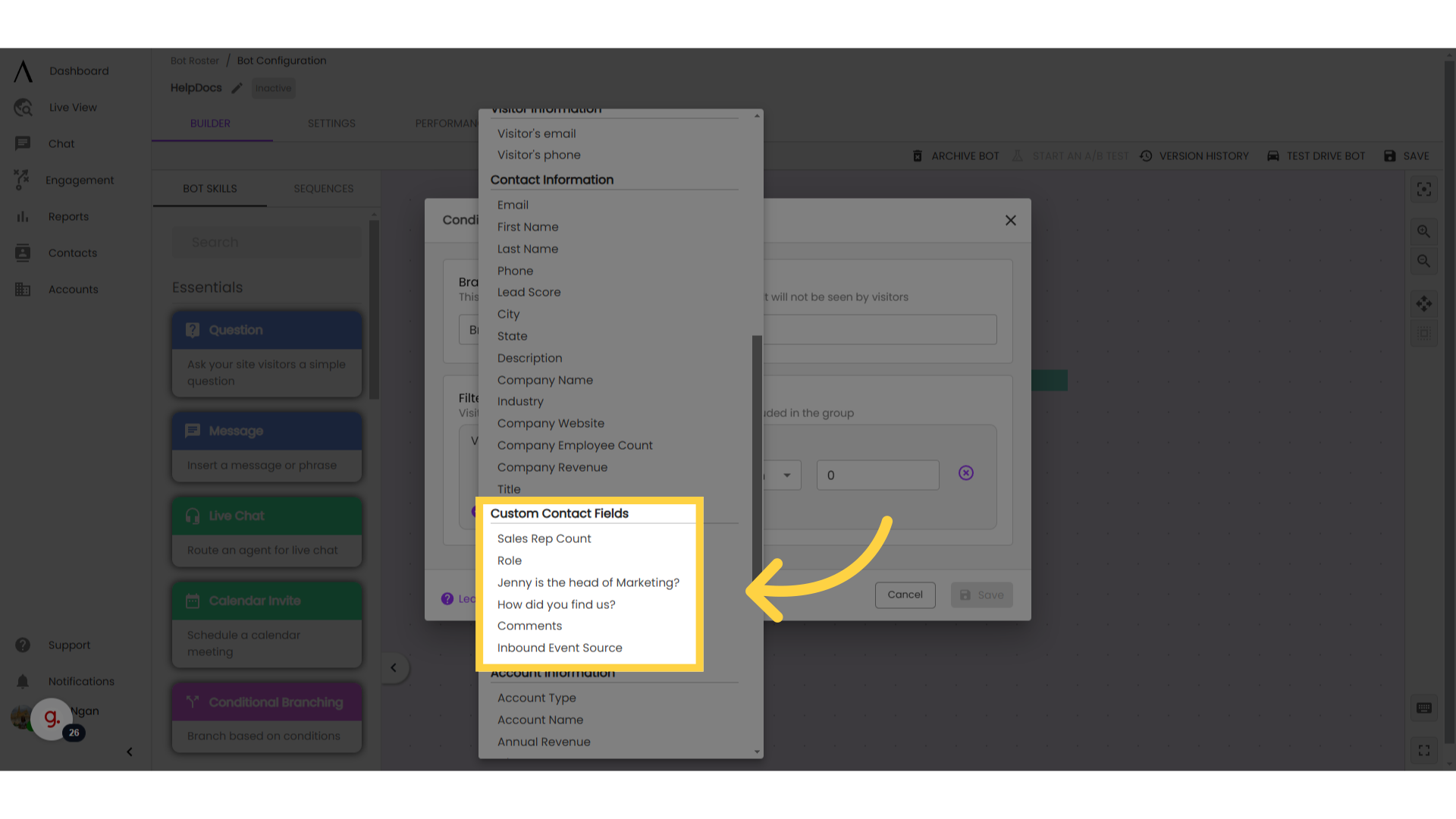
12. Create a custom contact field
To create this, click on "Contacts" in the left sidebar, then "Add Custom Field" in the upper-right corner. Set up the details of your field.
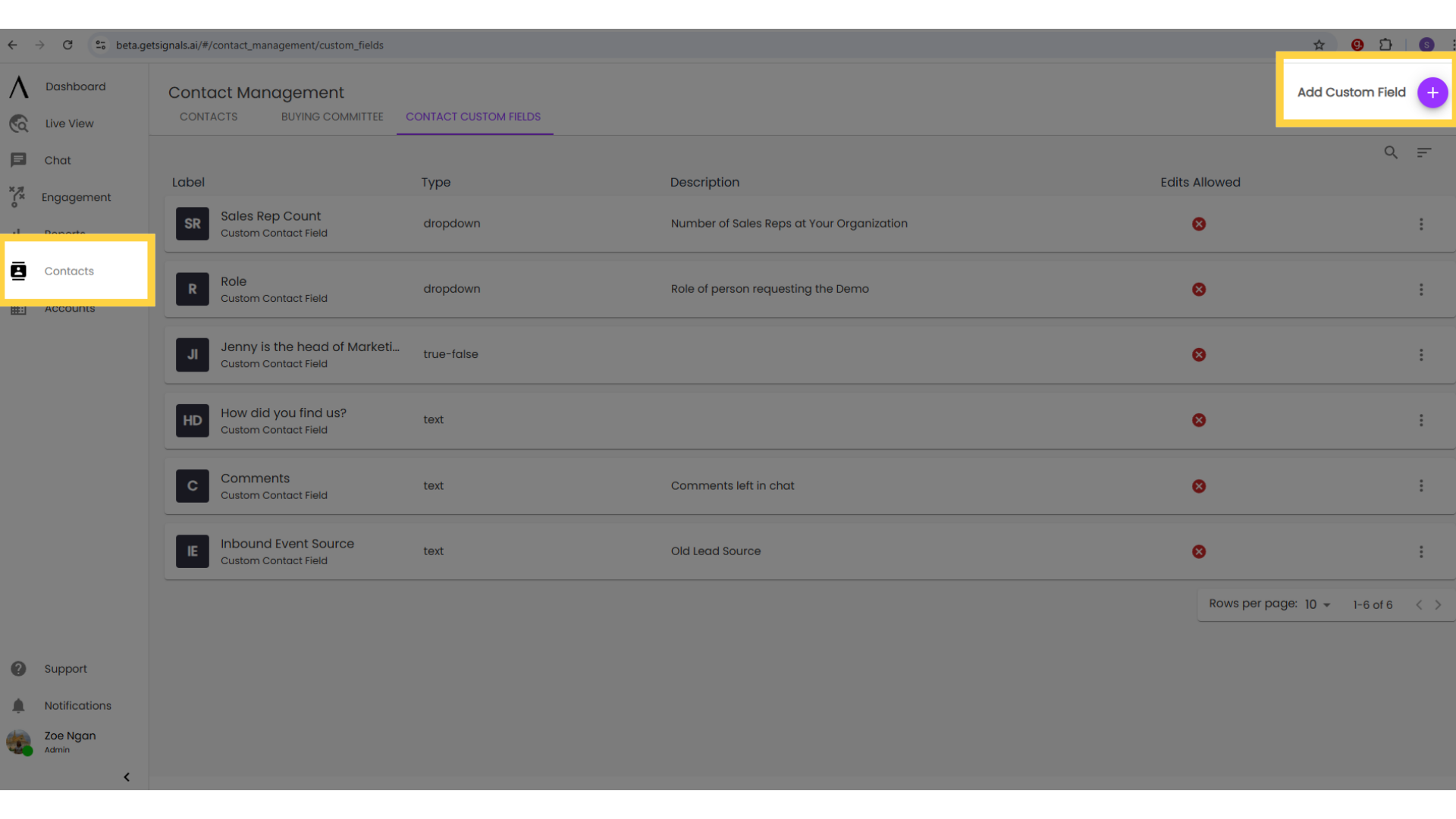
13. Account Information
Create branches based on any saved fields in the visitor's company record. All account fields will appear in the drop-down menu for this criterion.
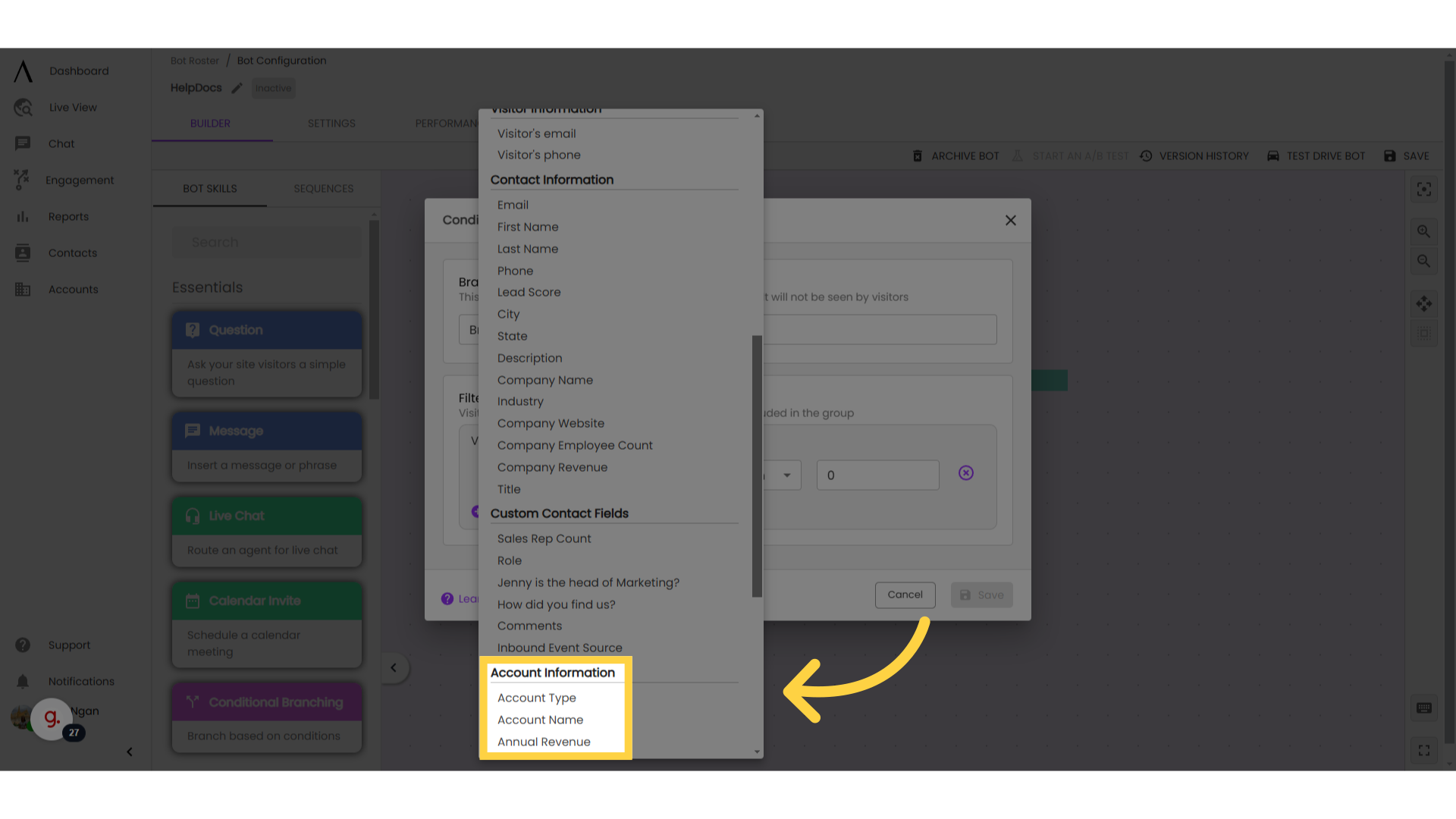
14. Segments
Create branches within your chatbot based on segments created in Signals or, if integrated, 6sense.
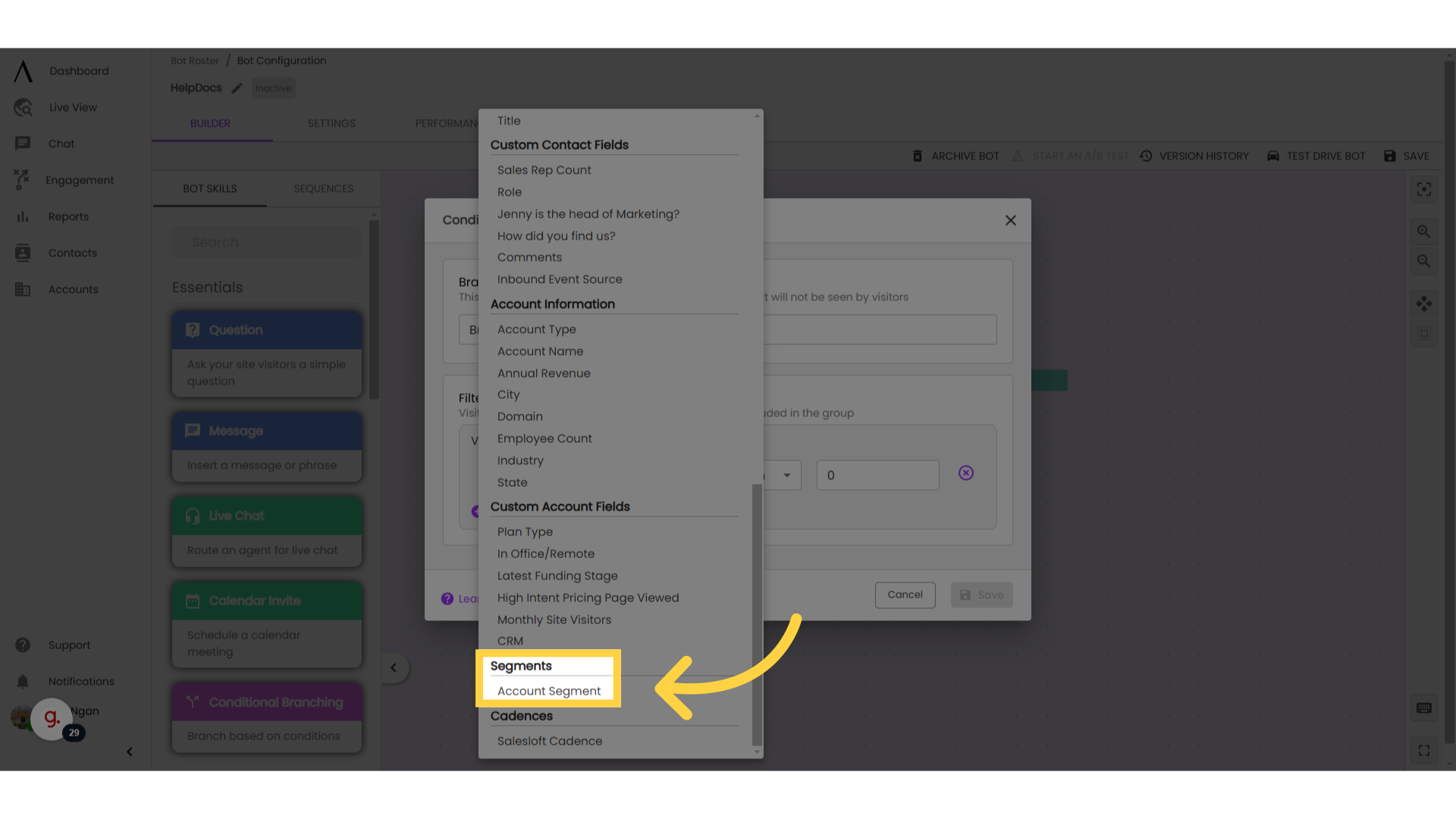
15. Multiple branches:
The conditional branching skill evaluates branches in sequential order, top to bottom within the skill. If a site visitor meets criteria for more than one branch, they will be included in the first branch whose criteria they match.
For example: Suppose you have a conditional branching skill with the following branches in the following order: ICP, current customer, and country not in US. If someone comes to your website from France who is a current customer and their company matches your ICP segment criteria, they will be assigned to the first branch whose conditions they meet. Thus, they will follow the first branch, Company Segment in ICP.
Note: For best results, place your most restrictive conditions first, and your widest net conditions last.
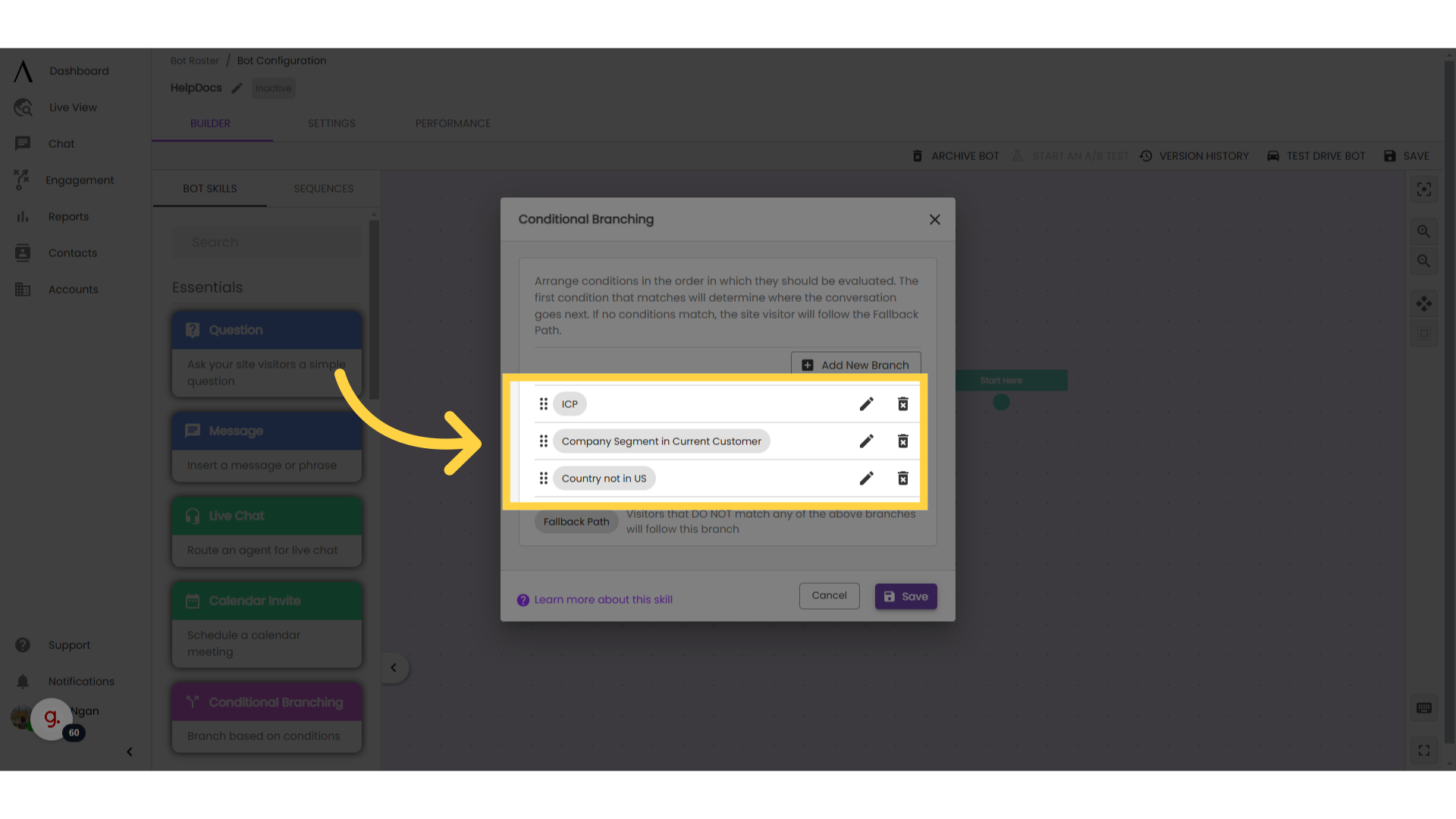
16. Branch priority:
Change the priority of your branches by clicking and dragging these icons to the left of your branch name.
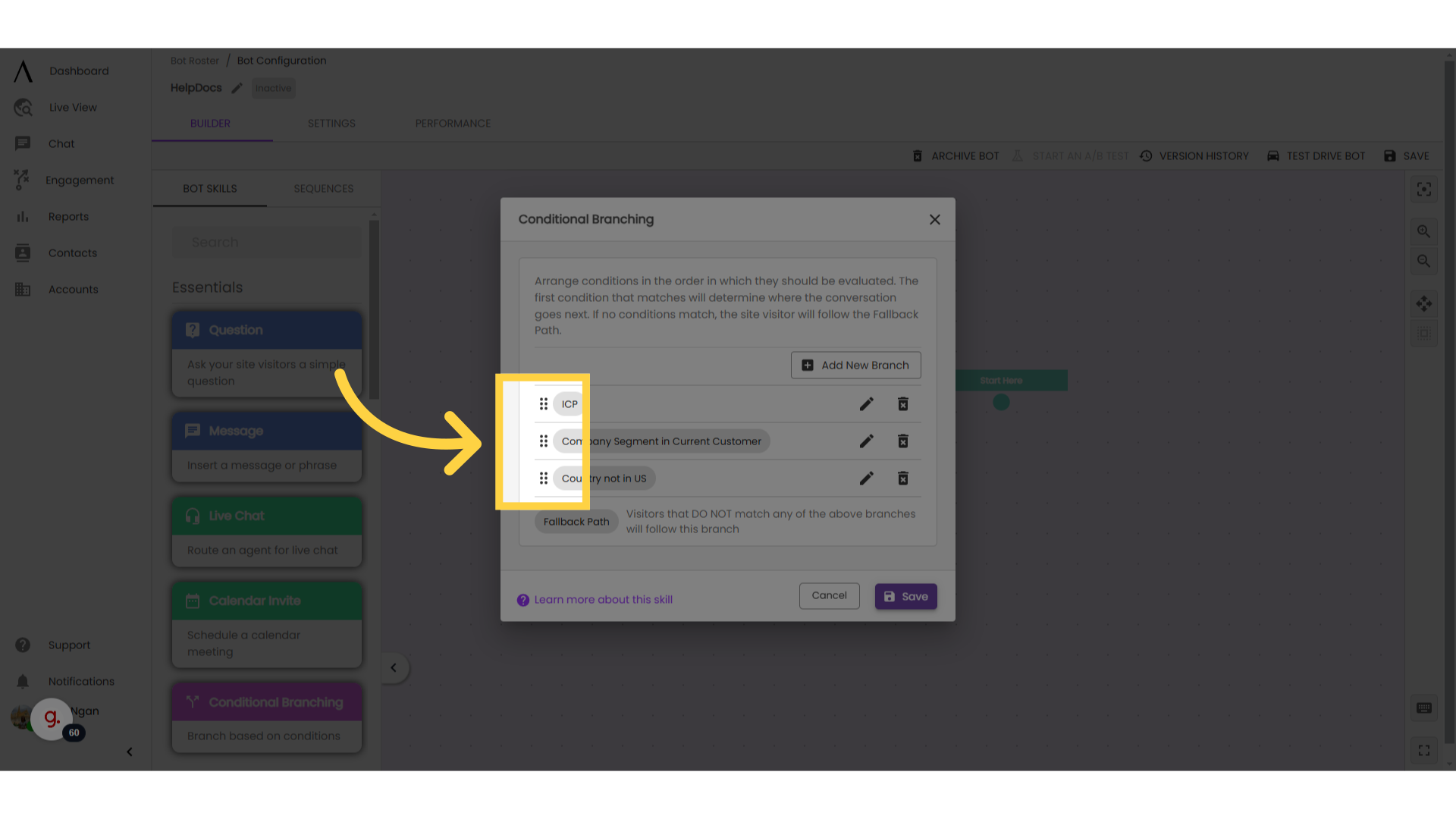
17. Configure fallback path
By default, the conditional branching skill includes a fallback path for site visitors who don't meet the criteria of any created branches. This fallback path must by nature be the lowest priority branch and cannot be moved or edited.
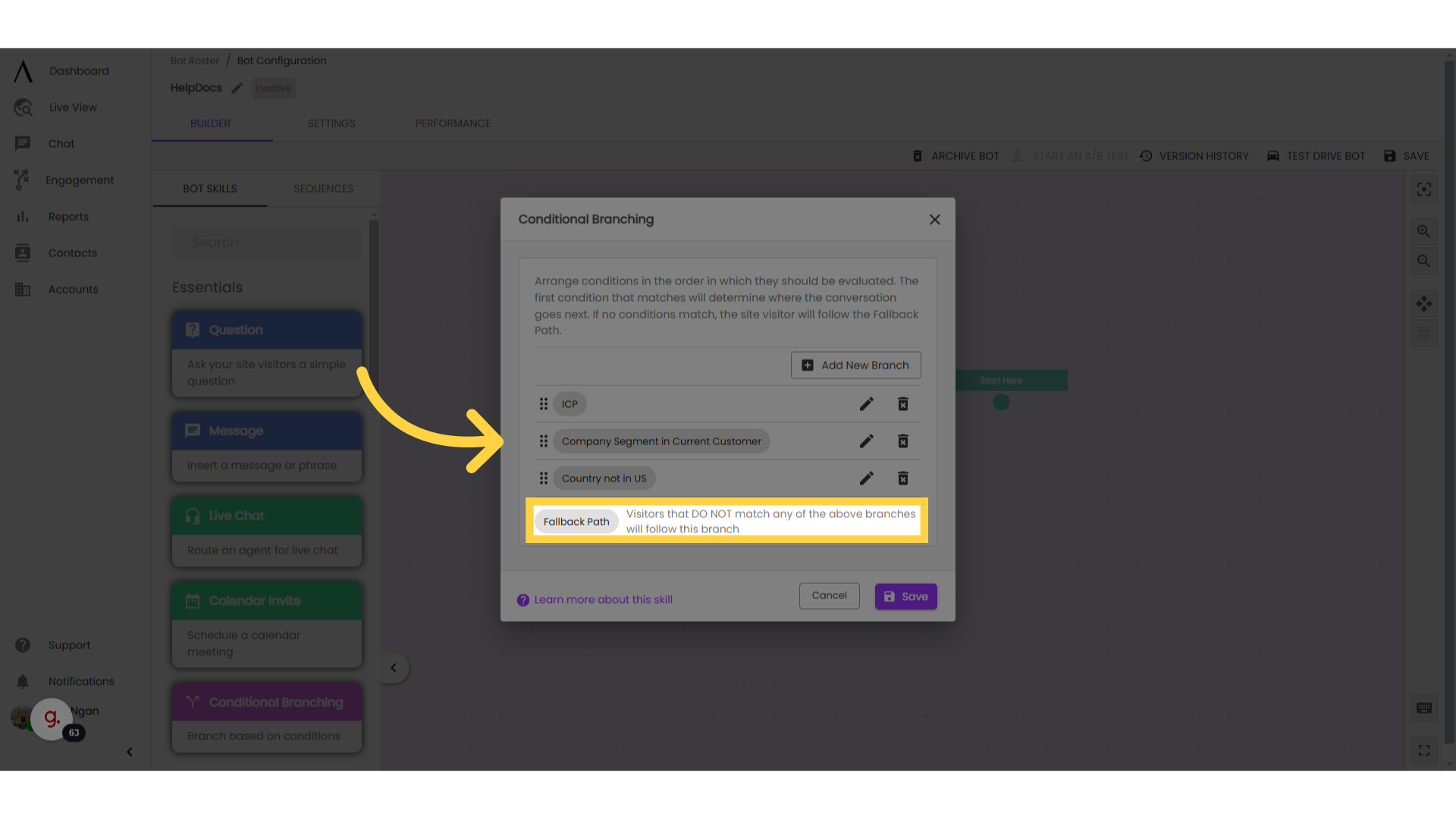
18. Common Uses
Common uses for conditional branching include data capture. Once a site visitor's email and phone number are already known, skip these questions in future conversations.
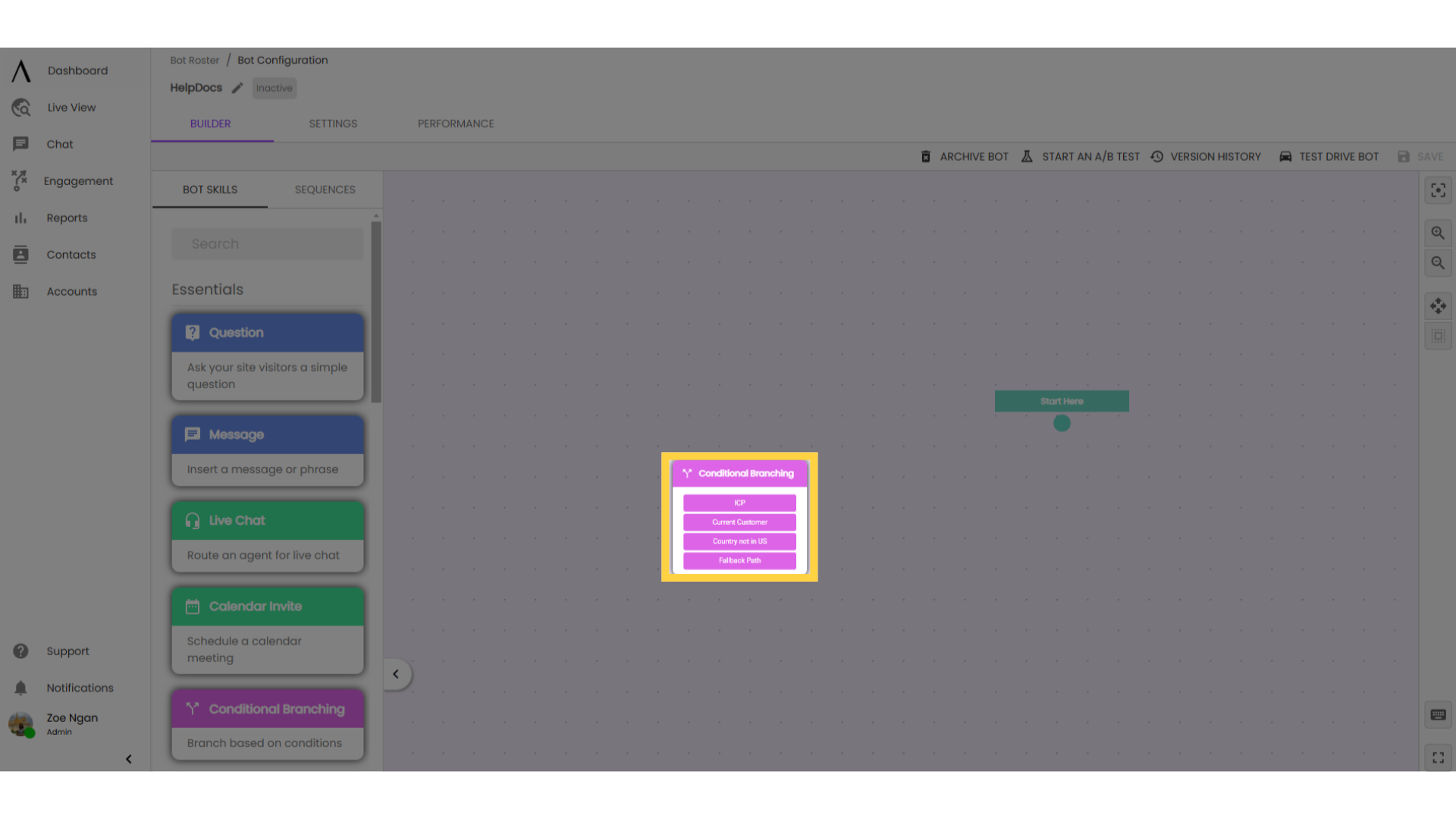
19. Data capture use case:
Common uses for conditional branching include data capture. Once a site visitor's email and phone number are already known, skip these questions in future conversations.
You can insert a conditional branching skill before your email capture skill (name the branch email is known), then connect the fallback path to the email capture skill. This way, visitors who haven't given an email before will still be asked. Connect Email Known branch to the next step in the bot flow, skipping email capture.
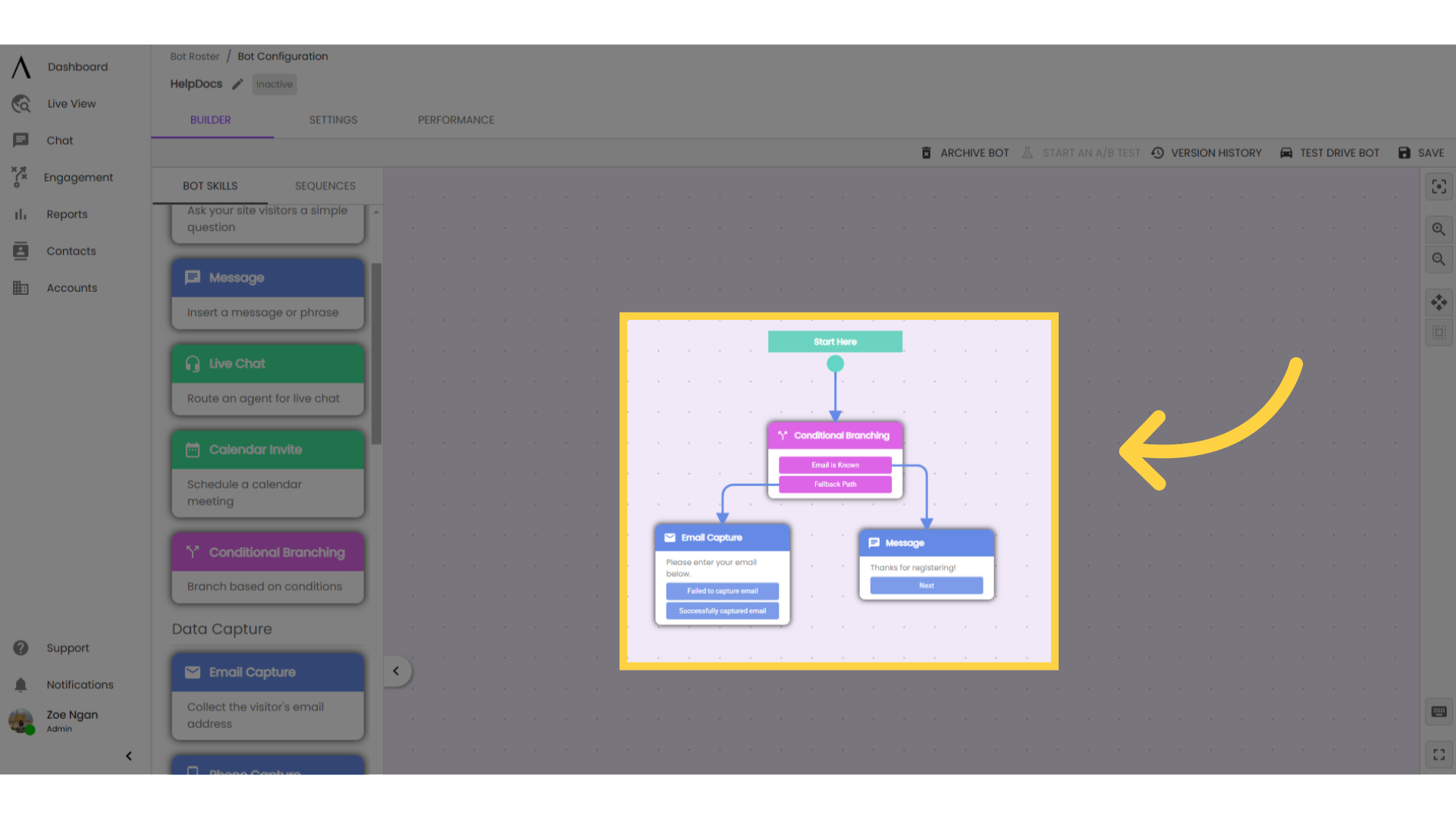
20. Regional routing use case:
Another common use case is regional routing. Route a different team or agent to live chat depending on the site visitor's location. For more about this, check out our HelpDocs video about regional routing.
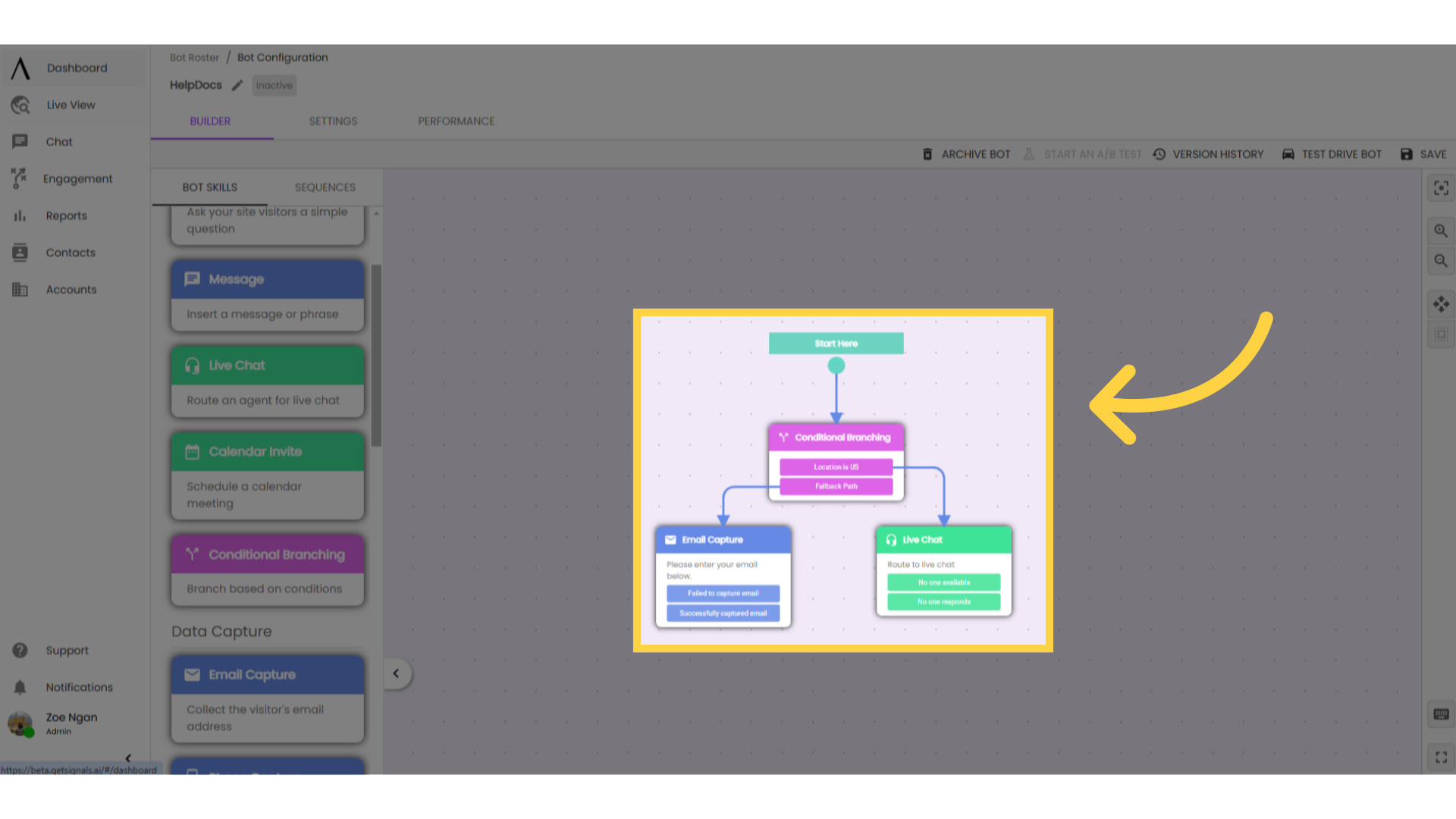
21. Agent/Team availability use case:
You can also only offer live chat during company or team availability. To do this, insert a conditional branching skill before your live chat skill (or your question skill with button options including live chat).
Name your branch Company/Team is online, then connect the fallback to a flow that doesn't include options for live chat (book a meeting, leave a message, or content recommendations). Connect Available branch to live chat (or a question skill that includes live chat as a button option)
